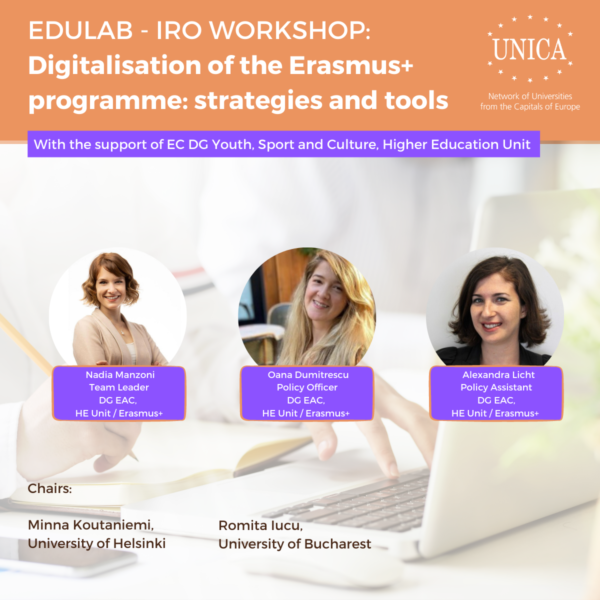Digitalisation of the Erasmus+ programme: strategies and tools, 14 September 2021 // Report
24 September 2021 | From UNICA

Digitalisation of the Erasmus+ programme: strategies and tools
UNICA EduLAB – IRO Group Workshop with the support of DG EAC
Ahead of the launch of the E+ App, the UNICA EduLAB and IROs working groups organised the workshop “Digitalisation of the Erasmus+ programme: strategies and tools” on 14 September 2021.
The online event, supported by the Higher Education Unit of the DG for Education, Youth, Sport and Culture, gathered around 100 participants from all around Europe, interested in learning more about the initiatives related to the new Erasmus+ programme and sharing their questions and views.
During the event, Nadia Manzoni, Alexandra Licht and Oana Dumitrescu (DG Education, Youth, Sport and Culture) delivered presentations of the European Student Card Initiative, European Student Identification (ESI) and the Erasmus+ app. By the end of this September, these initiatives will become available to the students and make the Erasmus+ mobility easier and more accessible.
In view of achieving the European Education Area by 2025, interconnectivity among European Universities is a prerequisite which naturally calls for a digitalisation of the current processes related to mobility. This would ease the administrative burden, and make information related to students, the host university, and courses more accessible to all actors involved in the mobility process. It goes without saying that enhanced mobility experience would also create a stronger sense of European citizenship among the young generations, a key priority of the EU. The audience applauded the ESI initiative: students often have to enter a big amount of data, even if sometimes that data is already available for the HEI. However, the initiative earned some critiques, especially of those which already dispose of interfaces/solutions for students. The EU representatives advised that HEIs should look at the added value of the initiative: the app would be the single entry point for students, if HEIs agree on.

Efforts should be made by both actors
This transition is not a one-way process: simultaneously to the transformation promoted by the EC, HEIs should adopt digitalised practices and adapt their systems to the initiatives promoted. The EC sees the current academic year as a transition period, and foresees OLAs and IIAs to be used by all HEIs as of 2022/2023. The three speakers presented a draft of the timeline for the IT infrastructures for the future:
• 2022- OLA for traineeship, students nominations and application
• 2023- Transcript of records, OLA for international mobility, Multilateral IIA
• 2024- Grant Agreement for participants, staff mobility agreement, OLA international staff mobility, OLA international traineeship
• Fully digital mobility administration by 2025
The EC is well aware of the challenges faced by most of the European HEIs, and so the timeline might be adapted to the needs of universities. Moreover, the programme has dedicated and will dedicate a lot of resources to support universities in this challenging process. The Commission will also provide a dashboard (a web solution for exchanging data electronically for the HEIs lacking the required software) for the HEIs lacking appropriate IT providers/team. UNICA, again with the support of the DG for Education, Youth, Sport and Culture is also planning another event especially designed for the IT teams within HEIs. Another important initiative in the framework of the new Erasmus+ programme is the E+ App, available in all EU languages, which provides students with their virtual European Student Cards. As universities are key in reaching out to students, the EC has prepared an online toolkit for HEIs to facilitate the promotion.

HEIs are not alone in the process
Given that every major transition implies challenges and concerns that should be properly addressed, one of the goals of the event was to provide a space for the representatives of the HEIs and EC where they can exchange their views and see the other side of the coin. The first question was related to non-EU countries. Nadia Manzoni underlined that the ones which already are Erasmus+ Programme countries are involved in the implementation of the ESCI. It is planned that partner country HEIs will also be involved in the digitalisation of interinstitutional agreements and LAs for international mobility but only at a later stage, as many preconditions need to be met first (related to data security, for example). Another concern has been the guidance provided by the EC. As for the exchange of information among international officers and Erasmus coordinators of HEIs, there is an unofficial tool shared by participants, where any interested person can join.
Overall, the digitalisation process of the Erasmus+ programme is a work in progress – and it shall continue to be in the years to come. The new tools – Erasmus Without Paper, the European Student Identifier, the European Student Card, and the E+ app – are the result of projects that were implemented in the previous Erasmus+ programme, proving its inherent open-ended feature.
Both the European Commission and Higher Education Institutions have common objectives, however, when it comes to implementation, there’s a multiverse of practices that need to be met at a single level. For this to happen, it will be crucial that HEIs and the EC work hand-in-hand and all actors have appropriate resources to make ambitious goals a reality.
Did you miss the event? Watch the recording!


 Co-funded by the European Union. Views and opinions expressed are however those of the authors only and do not necessarily reflect those of the European Union or the European Education and Culture Executive Agency (EACEA). Neither the European Union nor the granting authority can be held responsible for them.
Co-funded by the European Union. Views and opinions expressed are however those of the authors only and do not necessarily reflect those of the European Union or the European Education and Culture Executive Agency (EACEA). Neither the European Union nor the granting authority can be held responsible for them.